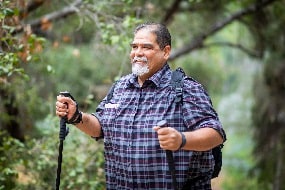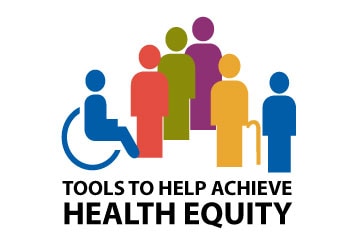Obesity, Race/Ethnicity, and COVID-19
Obesity is a common, serious, and costly chronic disease. Having obesity puts people at risk for many other serious chronic diseases and increases the risk of severe illness from COVID-19. Everyone has a role to play in turning the tide against adult and childhood obesity and its disproportionate impact on racial and ethnic minority groups.
Obesity Worsens Outcomes from COVID-19
Adults and children with excess weight are at greater risk from COVID-19:
In adults:
- Having obesity increases the risk of severe illness from COVID-19. People who are overweight may also be at increased risk.
- Having obesity may triple the risk of hospitalization due to a COVID-19 infection.
- Obesity is linked to impaired immune function.
- Obesity decreases lung capacity and reserve and can make ventilation more difficult.
- More than 900,000 adult COVID-19 hospitalizations occurred in the United States between the beginning of the pandemic and November 18, 2020. Models estimate that 271,800 (30.2%) of these hospitalizations were attributed to obesity.
- A study of COVID-19 cases suggests that risks of hospitalization, intensive care unit admission, invasive mechanical ventilation, and death are higher with increasing BMI.
- The increased risk for hospitalization or death was particularly pronounced in those under age 65.
In children:
- While children with COVID-19 are less likely than adults to develop severe illness, children are still at risk of developing severe illness and complications from COVID-19.
- In a study of COVID-19 cases in patients ages 18 years and younger, those with obesity had a 3.1 times higher risk of hospitalization and a 1.4 times higher risk of severe illness when hospitalized, meaning that they were admitted to the intensive care unit, needed invasive mechanical ventilation, or died.
Obesity Disproportionately Impacts Some Racial and Ethnic Minority Groups
Racial and ethnic minority groups have historically not had broad opportunities for economic, physical, and emotional health, and these inequities have increased the risk of getting sick and dying from COVID-19 for some groups. Many of these same factors are contributing to the higher level of obesity in some racial and ethnic minority groups.
Hispanic and non-Hispanic Black adults have a higher prevalence of obesity and are more likely to suffer worse outcomes from COVID-19. Hispanic and non-Hispanic Black children also have a higher prevalence of obesity. In 2017–2018, obesity affected 19.3% of children ages 2 to 19 years. However, Hispanic and non-Hispanic Black children had an obesity prevalence of 25.6% and 24.2%.
Steps States, Partners, and Healthcare Providers Can Take

Obesity is a complex disease with many contributing factors. Policy makers and community leaders can work to ensure that their communities, environments, and systems support a healthy, active lifestyle for all. For more information, see What Can Be Done.
Steps to Take Now
Systemic change takes time, as does long-term weight loss. In addition to the steps everyone should take to prevent the spread of COVID-19, individuals can help protect themselves and their families by:
Eating a healthy diet

Eating a healthy diet with plenty of fruits and vegetables, lean protein, and whole grains as well as the appropriate amount of calories is important for your health, and can help with weight loss and preventing weight gain.8 Good nutrition can help support optimal immune function.9,10 A healthy diet can help prevent or support self-management of diseases such as heart disease and type 2 diabetes8, which also increase the risk of severe illness from COVID-19.
Being active
People who do little or no physical activity are more likely to get very sick from COVID-19 than those who are physically active. Regular physical activity helps you feel better, sleep better, and reduce anxiety. It can also help with preventing weight gain and when combined with calorie reduction, helps with weight loss.11 Physical activity can also help prevent diseases that increase a person’s chances of having severe illness from COVID-19 such as heart disease and type 2 diabetes.11 Emerging research suggests it may also help boost immune function.12,13
Getting enough sleep
Insufficient sleep has been linked to depression, as well as chronic diseases14 that may increase the risk of severe illness from COVID-19 such as heart disease, type 2 diabetes, and obesity.
Coping with stress

Stress during an infectious disease outbreak can sometimes cause changes in sleep or eating patterns, increased use of alcohol and tobacco, or worsening of chronic health problems.
Vaccinating Against COVID-19
Vaccination can also keep adults and children from getting seriously sick even if they do get COVID-19. Vaccinating children can help them stay in school and safely participate in sports, playdates, and other group activities. COVID-19 vaccines help protect whole families and slow the spread of COVID-19 in communities.
Over time, these actions can help individuals with obesity improve their overall health. And if they result in even modest weight loss, there are health benefits, such as improvements in blood pressure, blood cholesterol, and blood sugars. And with a healthy weight, the risk of severe illness from COVID-19 is reduced.
Learn more about what can be done to ensure communities, environments, and systems support a healthy, active lifestyle for all.
References
- The 2021 CDC Adult Obesity Prevalence Maps show the prevalence of self-reported adult obesity using data from the Behavioral Risk Factor Surveillance System. Data are available for 49 states, the District of Columbia, Guam, Puerto Rico, and the Virgin Islands.
- Tanaka, S. I., Isoda, F., Ishihara, Y., Kimura, M., & Yamakawa, T. (2001). T lymphopaenia in relation to body mass index and TNF‐α in human obesity: adequate weight reduction can be corrective. Clinical endocrinology, 54(3), 347-354.
- Alwarawrah, Y., Kiernan, K., & MacIver, N. J. (2018). Changes in nutritional status impact immune cell metabolism and function. Frontiers in immunology, 9, 1055.
- Simonnet, A., Chetboun, M., Poissy, J., Raverdy, V., Noulette, J., Duhamel, A., … & LICORN and the Lille COVID‐19 and Obesity study group. (2020). High prevalence of obesity in severe acute respiratory syndrome coronavirus‐2 (SARS‐CoV‐2) requiring invasive mechanical ventilation. Obesity.
- Kompaniyets L, Goodman AB, Belay B, et al. Body Mass Index and Risk for COVID-19–Related Hospitalization, Intensive Care Unit Admission, Invasive Mechanical Ventilation, and Death — United States, March–December 2020. (2021). MMWR Morb Mortal Wkly Rep 2021;70:355–361.
- O’Hearn M, Liu J, Cudhea F, Micha R, Mozaffarian D. (2021). Coronavirus Disease 2019 Hospitalizations Attributable to Cardiometabolic Conditions in the United States: A Comparative Risk Assessment Analysis. Journal of the American Heart Association. 2021 Feb;10(5):e019259.
- Kompaniyets, Lyudmyla, et al. “Underlying medical conditions associated with severe COVID-19 illness among children.” JAMA network open 4.6 (2021).
- US Department of Agriculture and U.S. Department of Health and Human Services. Dietary Guidelines for Americans, 2020-2025. 9th Edition. December 2020.
- Childs, C. E., Calder, P. C., & Miles, E. A. (2019). Diet and immune function. Nutrients. 2019 Aug 16;11(8):1933.
- Christ, A., Lauterbach, M., & Latz, E. (2019). Western diet and the immune system: an inflammatory connection. Immunity, 51(5), 794-811.
- US Department of Health and Human Services. Physical Activity Guidelines for Americans, 2nd edition. Washington, DC: U.S. Department of Health and Human Services; 2018.
- Nieman, D. C., & Wentz, L. M. (2019). The compelling link between physical activity and the body’s defense system. Journal of sport and health science, 8(3), 201-217.
- Jones, A. W., & Davison, G. (2019). Exercise, Immunity, and Illness. In Muscle and Exercise Physiology (pp. 317-344). Academic Press.
- Itani O, Jike M, Watanabe N, Kaneita Y. Short sleep duration and health outcomes: a systematic review, meta-analysis, and meta-regression. Sleep Med. 2017;32:246-256.
- National Institutes of Health, National Heart, Lung, and Blood Institute. Managing Overweight and Obesity in Adults: Systematic Evidence Review from the Obesity Expert Panel, 2013. https://www.nhlbi.nih.gov/health-topics/managing-overweight-obesity-in-adultsexternal icon.
- Food assistance programs and food system guidance during COVID-19
- Policy resources to support social determinants of health
- Health Equity Resource Toolkit for State Practitioners Addressing Obesity Disparities
- COVID-19: Health Equity Considerations and Racial and Ethnic Minority Groups – What We Can Do
- Strategies to support healthy food systems, create activity-friendly environments, and prevent obesity.
- Healthy Eating for a Healthy Weight
- Physical Activity for a Healthy Weight
- Adult BMI Calculator
- CDC’s Division of Nutrition, Physical Activity, and Obesity (DNPAO)
- DNPAO’s State and Local Programs
